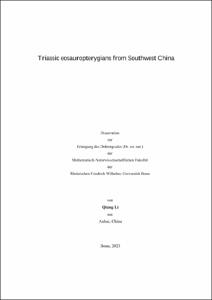Li, Qiang: Triassic eosauropterygians from Southwest China. - Bonn, 2024. - Dissertation, Rheinische Friedrich-Wilhelms-Universität Bonn.
Online-Ausgabe in bonndoc: https://nbn-resolving.org/urn:nbn:de:hbz:5-74416
Online-Ausgabe in bonndoc: https://nbn-resolving.org/urn:nbn:de:hbz:5-74416
@phdthesis{handle:20.500.11811/11342,
urn: https://nbn-resolving.org/urn:nbn:de:hbz:5-74416,
author = {{Qiang Li}},
title = {Triassic eosauropterygians from Southwest China},
school = {Rheinische Friedrich-Wilhelms-Universität Bonn},
year = 2024,
month = feb,
note = {Bone histology of Triassic marine eosauropterygians, which reveals insights into their ontogeny, the burial conditions that influenced fossil preservation, and the significance of morphology in understanding the paleoenvironment during the Anisian stage, are discussed in this dissertation.
Chapter 2 summarizes the stages of fossil preservation in the SW Chinese fossil Lagerstätten and identifies key factors influencing bone preservation. Observations of different bone tissue sections reveal that the poor preservation of some thin sections is due to specific burial conditions. In order to investigate the reasons behind the various preservation, dozens of materials from the Xingyi area were sampled. The results reveal that some bones in this region have undergone low-grade metamorphism. Additionally, this chapter reported for the first time that the formation of fluorite and a continuous apatite phase transformation within vertebrate fossils. These findings tell the primary signal in the difficult to understand Keichousaurus histology. It provides crucial support for selecting appropriate fossils when studying the bone histology of eosauropterygians across the different localities in southwestern China.
Insights from Chapter 2 allow the successful study of Keichousaurus histology for the first time, led to the discovery of a sexually dimorphic histological characteristics in Chapter 3. The bone histology of Keichousaurus reveals features of early sexual maturity and high bone compactness, similar to pachypleurosaurs from the western Tethys. Chapter 4 focuses on the sexually dimorphic histology, leading to the discovery of puberty in Keichousaurus.
The new pachypleurosaur described in Chapter 5 puts Keichousaurus into a phylogenetic and evolutionary perspective, providing new understanding of the intragroup relationships of eosauropterygians based on the discovery of new materials and comparative morphological study of different eosauropterygian taxa. The new nothosaur in Chapter 6 further contributes to the themes of sexual dimorphism, limb function, especially in conjunction with the track record, and the high diversity in the Chinese Middle Triassic Eosauropterygia and their importance for understanding eosauropterygian evolution in the Triassic.
In summary, the combination of methods applied across different chapters will establish useful methods for future research on the bone histology, morphology, and phylogenetic relationships of eosauropterygians in different Middle Triassic biotas from southwestern China. It will also facilitate a comprehensive exploration of the evolution of eosauropterygians from eastern and western Tethyan regions.},
url = {https://hdl.handle.net/20.500.11811/11342}
}
urn: https://nbn-resolving.org/urn:nbn:de:hbz:5-74416,
author = {{Qiang Li}},
title = {Triassic eosauropterygians from Southwest China},
school = {Rheinische Friedrich-Wilhelms-Universität Bonn},
year = 2024,
month = feb,
note = {Bone histology of Triassic marine eosauropterygians, which reveals insights into their ontogeny, the burial conditions that influenced fossil preservation, and the significance of morphology in understanding the paleoenvironment during the Anisian stage, are discussed in this dissertation.
Chapter 2 summarizes the stages of fossil preservation in the SW Chinese fossil Lagerstätten and identifies key factors influencing bone preservation. Observations of different bone tissue sections reveal that the poor preservation of some thin sections is due to specific burial conditions. In order to investigate the reasons behind the various preservation, dozens of materials from the Xingyi area were sampled. The results reveal that some bones in this region have undergone low-grade metamorphism. Additionally, this chapter reported for the first time that the formation of fluorite and a continuous apatite phase transformation within vertebrate fossils. These findings tell the primary signal in the difficult to understand Keichousaurus histology. It provides crucial support for selecting appropriate fossils when studying the bone histology of eosauropterygians across the different localities in southwestern China.
Insights from Chapter 2 allow the successful study of Keichousaurus histology for the first time, led to the discovery of a sexually dimorphic histological characteristics in Chapter 3. The bone histology of Keichousaurus reveals features of early sexual maturity and high bone compactness, similar to pachypleurosaurs from the western Tethys. Chapter 4 focuses on the sexually dimorphic histology, leading to the discovery of puberty in Keichousaurus.
The new pachypleurosaur described in Chapter 5 puts Keichousaurus into a phylogenetic and evolutionary perspective, providing new understanding of the intragroup relationships of eosauropterygians based on the discovery of new materials and comparative morphological study of different eosauropterygian taxa. The new nothosaur in Chapter 6 further contributes to the themes of sexual dimorphism, limb function, especially in conjunction with the track record, and the high diversity in the Chinese Middle Triassic Eosauropterygia and their importance for understanding eosauropterygian evolution in the Triassic.
In summary, the combination of methods applied across different chapters will establish useful methods for future research on the bone histology, morphology, and phylogenetic relationships of eosauropterygians in different Middle Triassic biotas from southwestern China. It will also facilitate a comprehensive exploration of the evolution of eosauropterygians from eastern and western Tethyan regions.},
url = {https://hdl.handle.net/20.500.11811/11342}
}






